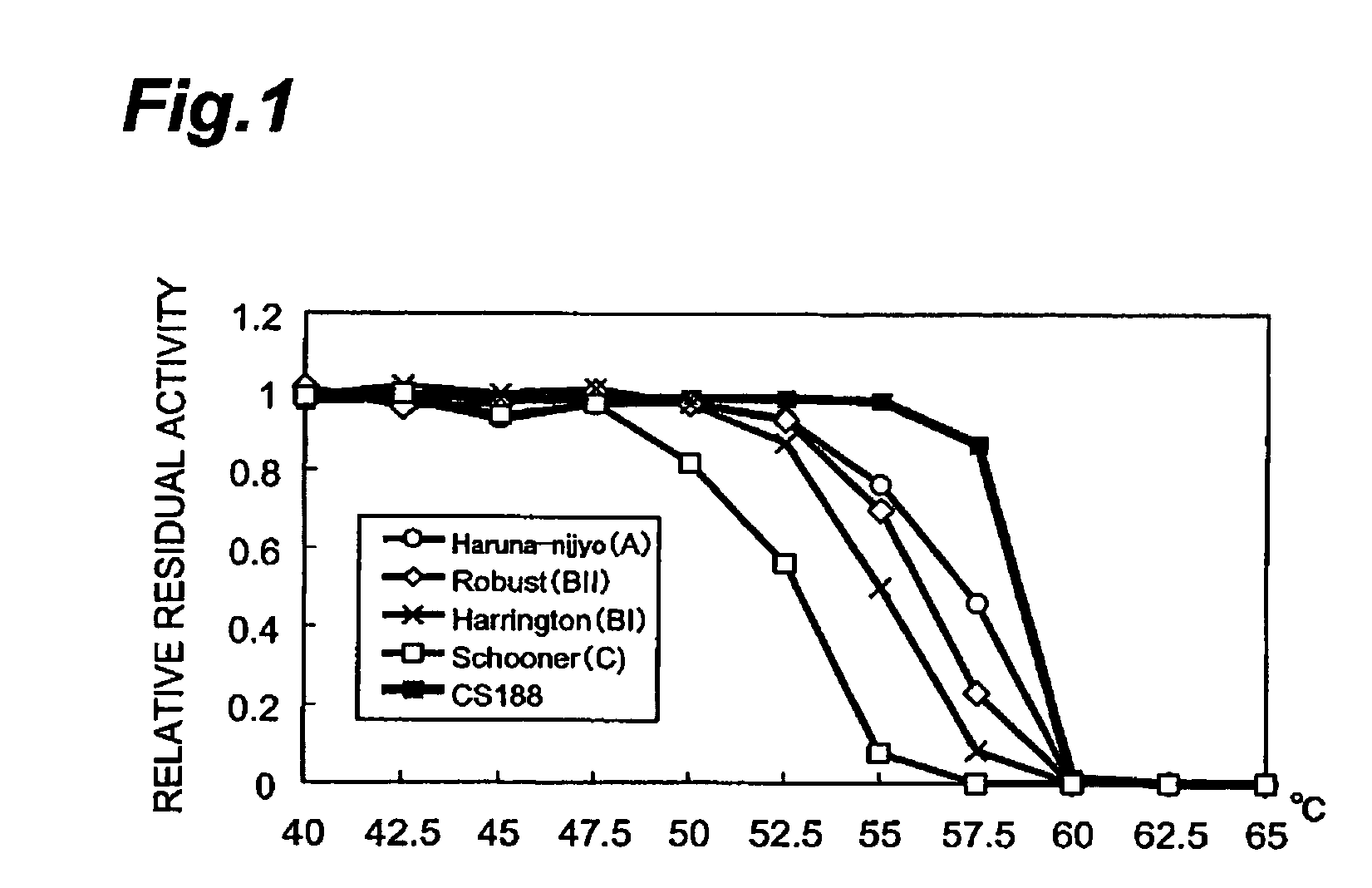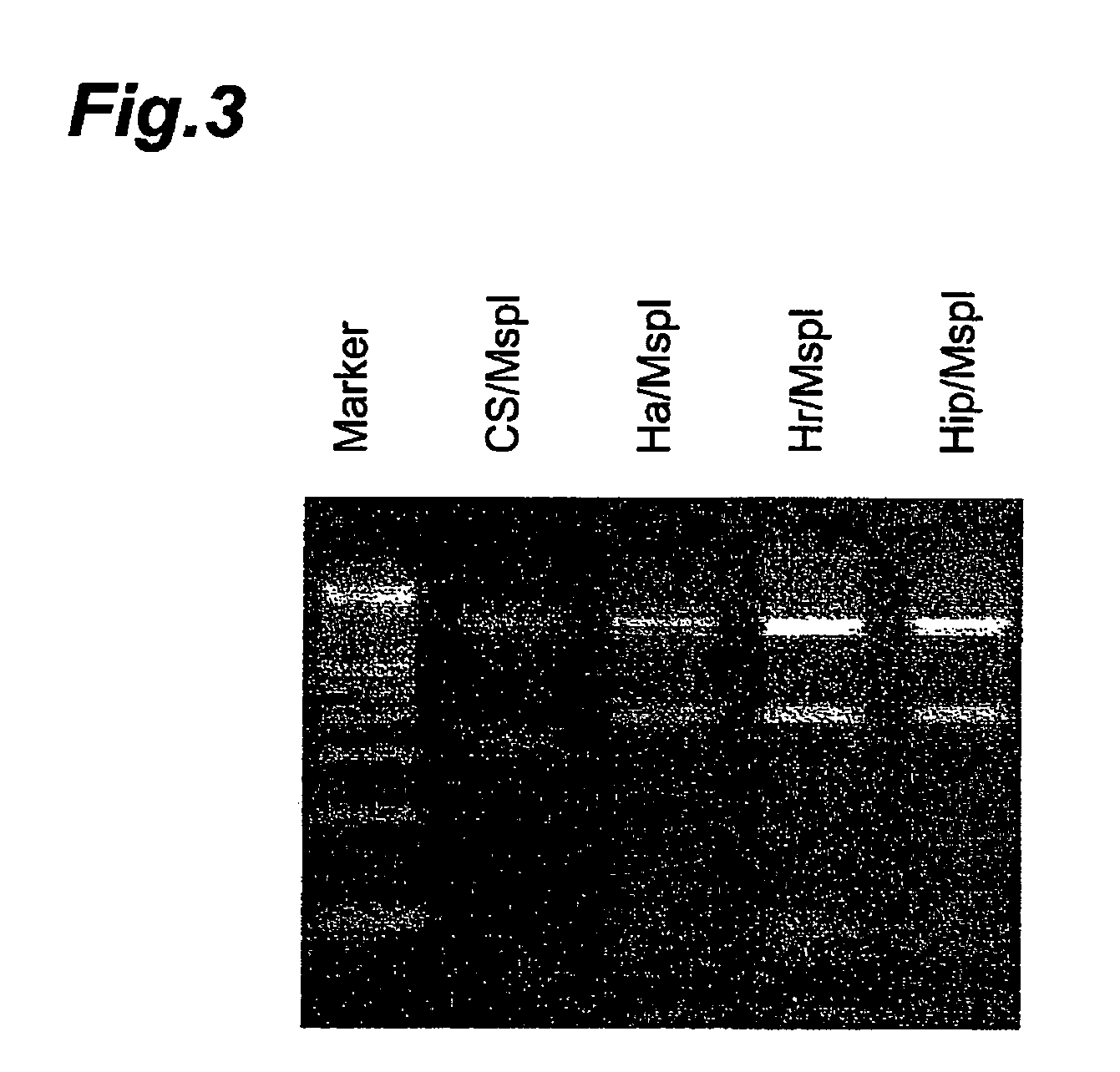Method of selecting barley variety, barley beta-amylase gene and process for producing malt alcoholic drink
a technology of barley betaamylase and process, applied in biochemistry apparatus and processes, organic chemistry, enzymes, etc., can solve the problems of difficult utilization of barley in breeding and a large amount of time, and achieve the effects of increasing starch decomposition efficiency, low molecular weight sugars, and increasing fermentation efficiency
- Summary
- Abstract
- Description
- Claims
- Application Information
AI Technical Summary
Benefits of technology
Problems solved by technology
Method used
Image
Examples
example 1
(Selection Method for β-amylase with High Thermostability by Heat Treatment Measurement)
[0095]A crude enzyme solution was first extracted from barley seeds. One grain of mature barley was pulverized with a hammer. Acetate buffer (50 mM, pH 5.5) containing 400 μl of 10 mM dithiothreitol was used to carry out extraction by reciprocating shaking at 4° C. for 12 hours at 100 rpm. After the extract was centrifuged at 15,000 rpm for 10 minutes, the supernatant was taken as a crude enzyme solution.
[0096]Heat treatment of β-amylase was then carried out. The crude enzyme solution was diluted to 100 fold with 50 mM MOPS buffer containing 1% BSA, and a 30 μl-aliquot was charged into a 200 μl-sampling tube and treatment was carried out at 57.5° C. for 30 minutes in a water bath.
[0097]Next, p-nitrophenylmaltopentaoside (Betamyl kit from Megazyme International) was used as the substrate to measure the β-amylase activity. Each 10 μl-aliquot respectively from the enzyme solutions in the heat-treate...
example 2
(Selection by DNA Polymorphism of β-amylase Character with High Thermostability)
[0099]Genomic DNA of the β-amylase gene extracted from CS188 was decoded by the dye-terminator method. As FIG. 2 shows, it was confirmed that the base at 291 bp from the start codon had been altered to C in the β-amylase gene isolated from CS188 as opposed to A in the case of the known β-amylase genes and the base sequence CCGG, which was a recognition site of restriction enzyme MspI, had formed.
[0100]Genomic DNAs were extracted from the spouting green leaves of CS188 and a regular variety by the SDS-propanol method. These were used as template DNAs. Each 50 μM of 5′-primer (5′-ATCATCCATAGCCAGCATCCACAATGGAGG-3′: SEQ ID NO:3) and 3′-primer (5′-CACTCACGATGAATTCTCCGATGCCTGGGA-3′: SEQ ID NO:4) was added to 1 μl of DNA and premix ExTaq. PCR amplification was performed on a 50 μl scale (72° C.×7 min after 30 cycles at 94° C.×1 min, 55° C.×2 min, 72° C.×3 min). The obtained PCR product (5 μl) was cleaved with r...
example 3
(Process for Production of Malt Alcoholic Beverage)
[0104]CS188 that had been identified as the barley having a β-amylase with high thermostability and OUC57+ for which the β-amylase thermostability was type A (as control) were steeped until their steeping degrees reached 42.5%. Subsequently, germination was allowed at 15° C. for 6 days and then roasting / drying produced malts. After the malts was ground, worts were produced in a saccharization process as shown in the diagrams of FIG. 5.
[0105]As FIG. 5 shows, the degree of deactivation of β-amylase during saccharization is such that CS188 maintained high activity until a later stage of saccharization when the temperature rose. It was thus anticipated that saccharization would proceed efficiently.
[0106]Next, a small-scale fermentation test was carried out according to the EBC standard method by using the obtained worts to determine the final apparent attenuation. Consequently, the final apparent attenuation of CS188 was 77.8%, which wa...
PUM
| Property | Measurement | Unit |
|---|---|---|
| temperature | aaaaa | aaaaa |
| pH | aaaaa | aaaaa |
| temperature | aaaaa | aaaaa |
Abstract
Description
Claims
Application Information
 Login to View More
Login to View More - R&D
- Intellectual Property
- Life Sciences
- Materials
- Tech Scout
- Unparalleled Data Quality
- Higher Quality Content
- 60% Fewer Hallucinations
Browse by: Latest US Patents, China's latest patents, Technical Efficacy Thesaurus, Application Domain, Technology Topic, Popular Technical Reports.
© 2025 PatSnap. All rights reserved.Legal|Privacy policy|Modern Slavery Act Transparency Statement|Sitemap|About US| Contact US: help@patsnap.com



